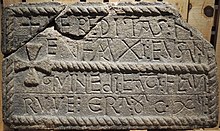San Pedro de Rocas
San Pedro de Rocas is a medieval rock monastery in the wild and romantic mountain landscape in the south of Galicia in north-west Spain .
location
The church of San Pedro de Rocas is located in the municipality ( municipi ) of Esgos in the north of the province of Ourense in the autonomous region of Galicia . It is located about one kilometer north of the village in a wooded landscape interspersed with granite rocks at an altitude of about 600 meters above sea level. d. M. The city of Ourense is about 20 kilometers (driving distance) to the west.
history
In the church there was an inscribed stone slab framed by ropes from the year 537, which names the names of several monks ( Eufraxi, Eusani, Quinedi, Eeaci, Flavi and Ruve ) who had taken over ("inherited") the hermit monastery , which was hidden, from which it can be concluded that a religious site already existed on this site. The plate is now in the Museo Arqueolóxico de Ourense . In the 8th century the site was abandoned because of the advance of the Moors and - according to legendary tradition - it was rediscovered around 100 years later by a hunter named Gemondus , whereupon a small community of monks or hermits formed again. The kings Alfons III. of Asturias , Alfonso VII of León , Ferdinand IV of Castile and Henry III. von Castile donated funds to maintain or expand the monastery, which had now adopted the Benedictine rule. At times it was a priory of the Santo Estevo de Ribas de Sil monastery before it joined the San Miguel de Celanova monastery in the 15th century . In the 19th century it was under the disentailment dissolved and continue to be used as a parish.
architecture
Monastery building
The masonry parts of the monastery complex mostly date from the 16th to 18th centuries. They are architecturally rather simple and nowadays partly serve as a museum and information center.
Rock church
In the 15th century, a bell gable ( espadaña ) with lateral spherical attachments was built on a granite rock . A few meters behind it is the - easy to defend - access to the forecourt of the church. Several stone box tombs have been carved into the rock in front of and in the church , in which the monks, but very likely other prominent figures, found their final resting place.
The church, which is partially hewn out of the rock, is less of historical importance than of historical importance. Its floor plan is in three parts, with the 'side aisles' also being referred to as 'chapels' because they are only partially connected to the central nave. The church portals are bricked and, to a small extent, also profiled . In the central apse there is an altar made of two stones and a modern cross, which is based on medieval crucifixes from northern Spain.
A former altar from San Pedro de Rocas with rope ornamentation and two horseshoe arches is also exhibited in the Museo Arqueolóxico de Ourense .
Web links
Coordinates: 42 ° 20 ′ 32 " N , 7 ° 42 ′ 48" W.






